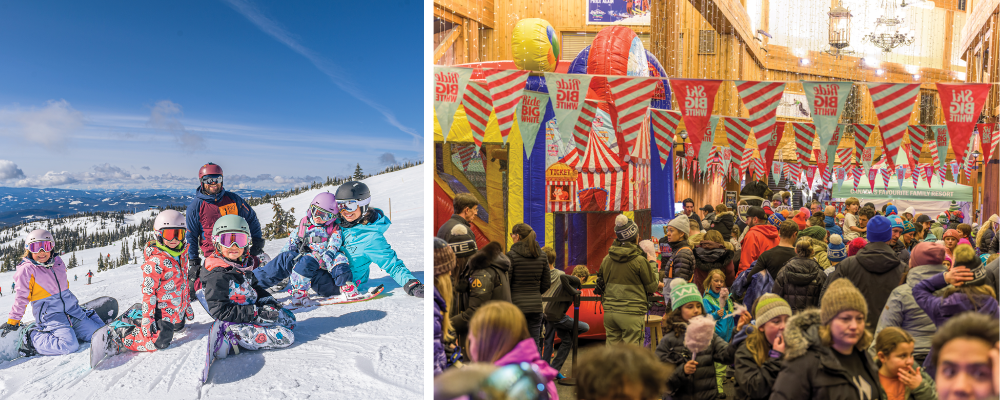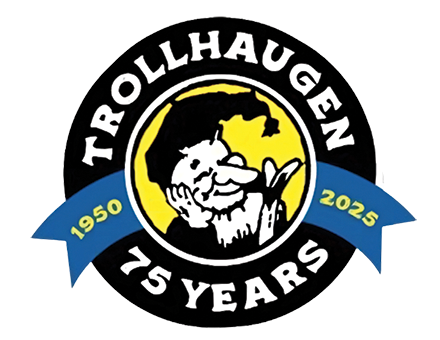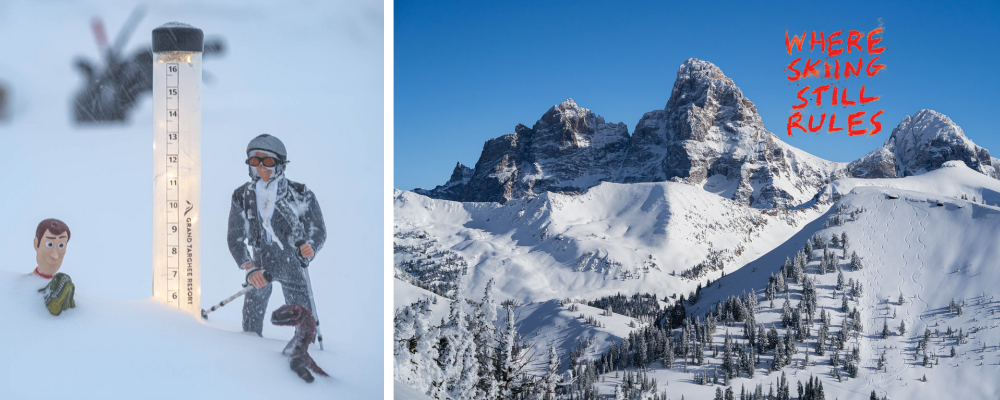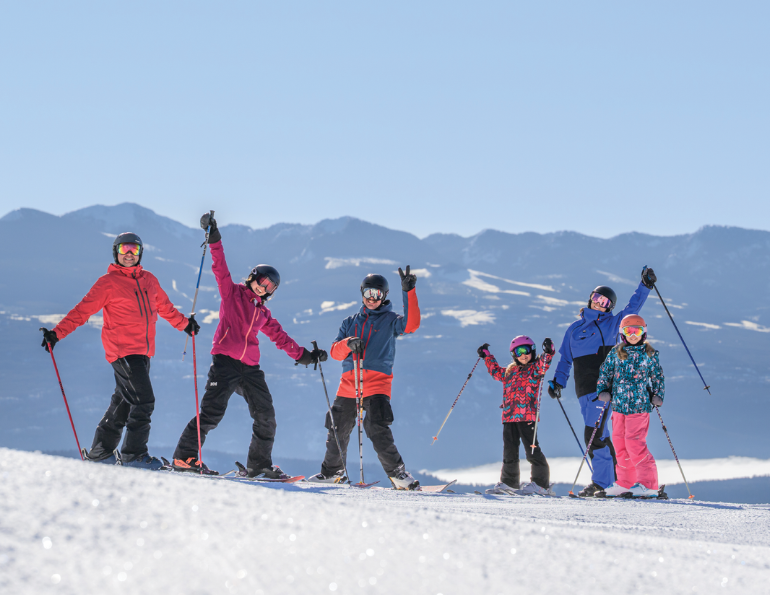For guests traveling from near and far to enjoy mountain escapes, resorts have an opportunity to lean into their unique brand personality to deliver an exceptional experience. In a world ripe with prefabricated offerings, it’s the authentic touches that stand out, the ones that create the magic moments guests crave.
So, how can your brand capture what makes your mountain one of a kind? Let’s explore some ways.
1. Fence Your Purpose
Define your resort’s mission. The clearer your mission is, the easier it becomes to use it as a driving force for both strategy and day-to-day decision making.
Big White Ski Resort, located near Kelowna in British Columbia, has built its brand upon the promise of being “Canada’s favorite family resort.” Since the Schuman family purchased Big White in 1985, the mountain resort has been driven by this singular focus. Operational, marketing, programming, and even culinary decisions are all made through a family-friendly decision matrix.
Fun for all in the family. For example, nestled high in the Monashee Mountains, Big White offers a mix of terrain—long, challenging runs, a great learning area, and a big, all-skills terrain park. Unlike most other resorts of its size and terrain variety, though, Big White’s marketing and programming focuses almost exclusively on good old-fashioned family fun. That focus has allowed Big White to curate a loyal guest base.
“We wanted to provide families with activities to enjoy both during the day and in the evenings,” particularly during holiday periods, says senior VP Michael J. Ballingall. “Through kid-specific programming, we’ve been able to grow a holiday experience where parents can connect with other parents while their kids make new friends.”
A standout is Carnival Night, where kids run free among games and activities while parents relax nearby. “Many lifelong friendships have sparked at Carnival,” says Ballingall. “As a result, what we saw was the families that met and formed friendships at Big White would plan to return together the following winter, and the following winter for their now annual ski holiday.”
 Big White, B.C., makes marketing and programming decisions through a family-focused lens, with events like Carnival Night (right) driving guest loyalty.
Big White, B.C., makes marketing and programming decisions through a family-focused lens, with events like Carnival Night (right) driving guest loyalty.
2. Shape Your Visual Identity
How do guests know a message is coming from you?
Work to develop a distinct visual identity. Your visual identity is more than just your logo. It extends to color schemes, typography, imagery, and guest service training that reflect your resort’s personality.
 The vintage charm of Trollhaugen’s (Wis.) visual brand elements conveys the ski area’s mom-and-pop values.A great example of clear visual identity comes from the Midwest, where in 1940, two friends founded a small resort in Wisconsin, which they named Skyline Ski Area. The area was born out of frustration: the two friends were tired of driving hours to ski. Plus, they wanted to create a ski experience that celebrated community.
The vintage charm of Trollhaugen’s (Wis.) visual brand elements conveys the ski area’s mom-and-pop values.A great example of clear visual identity comes from the Midwest, where in 1940, two friends founded a small resort in Wisconsin, which they named Skyline Ski Area. The area was born out of frustration: the two friends were tired of driving hours to ski. Plus, they wanted to create a ski experience that celebrated community.
A friendly Troll. As more community members took to the slopes, the resort asked its community to help it pick a new name. The winning suggestion, Trollhaugen—a Norwegian word meaning “Home of the Trolls”—was submitted by a schoolteacher.
With the new name came a new logo and font, both with a hand-drawn, mid-century look. The logo features the profile of a troll, and the fairy tale font complements the art beautifully. You can spot the troll’s face nearly everywhere. It’s in the terrain park, the lodge, on Instagram, and on the trail map.
The brand elements may appear kitsch on first impression, but the mom-and-pop aesthetic silently communicates the resort’s values. “Our guiding principle is to be the anti-corporate ski area of yesteryear,” says director of marketing Marsha Hovey. “Being the resort of yesteryear to us means working to keep skiing and snowboarding approachable and accessible for newcomers, and nostalgic and pure for returning guests.” The logo’s vintage charm conveys that.
3. Stick the Landing on Your Mountain’s Voice
Mountain resorts and mountain towns have their distinct personalities and quirks. You bring yours to life through communication. Your resort’s voice is a culmination of the tone, language, and messaging used to communicate with your audience.
Wyoming’s Grand Targhee is a great example of owning and sticking to your voice. Loved by locals and destination guests alike for its humble attitude, sense of humor, big mountain offerings, unbeatable views of Grand Teton, and ample snow, Targhee has built a strong brand through a consistent voice that celebrates skiing.
Howdy, partner. “Since the lifts started spinning back in 1969, Grand Targhee has adopted a laid-back attitude, focusing on keeping it simple—good skiing, good snow, good care, and good fun. We are a resort built and operated by skiers and snowboarders for skiers and snowboarders. And that’s how we’d like to keep it,” says senior marketing manager Jordan Wilsted.
Targhee’s tagline “where skiing still rules” is reflected throughout the resort. “When you ski or ride at Grand Targhee, we want you to feel that we care about you and you having an authentic ski experience,” Wilsted says. That means the resort is invested in quality grooming and ensuring minimal lift lines, as well as in employees that share a stoke for skiing and riding. From parking attendants to lift operators and mountain staff, Targhee’s personnel embody the resort’s “skier-centric” brand.
Showing care doesn’t mean being fussy, though. Whether you’re carving the slopes of Targhee or cruising the resort’s website, you’ll notice its distinct laid-back tone, brought to life with humor, puns, and colloquialisms in the resort’s branding, advertising, and day-to-day communications.
The vibe connects with guests, resulting in high guest engagement with Targhee’s direct marketing channels, and is echoed in the on-the-ground experience. For example, you can locate your car in the parking lot via parking row signs sporting animal silhouettes—these, including a Narwhal, not only help guests remember where they parked, but also set a fun tone for the day on the hill. Sign up for your master’s in SHRED at ski school. And come summer, enjoy Mellowstone at Targhee, or “summer as it should be,” an experience governed by anti-rules like “Go bearbarefoot,” “laugh a lot,” and “explore more.”
 Grand Targhee, Wyo., brings a laid-back, skier-centric voice to its marketing that is reflected on the ground through quirky touches like the resort’s snowfall measurement “stick of truth.”
Grand Targhee, Wyo., brings a laid-back, skier-centric voice to its marketing that is reflected on the ground through quirky touches like the resort’s snowfall measurement “stick of truth.”
4. Groom Your Resort Story
Use storytelling to share history, values, and what sets you apart.
Banff Sunshine, in Banff, Alberta, is fast approaching its 100th birthday. The resort’s Old Sunshine Lodge was initially built in 1928 as part of an expansion of activities for the CP hotel chain. At the time, the Canadian Pacific Railway sought ways to boost travel to the awe-inspiring Canadian Rockies. The Old Sunshine Lodge was built as a high-alpine camp for outdoor enthusiasts.
The railroad quickly realized that Banff Sunshine was a magnet for snow. From the winter of 1928, skiers began touring up the mountain to ski its smoke-dry powder. The resort built its first lift, the Strawberry Poma, in 1935.
Rooted in history. Today, the mountain is renowned for its terrain, which caters to skiers and snowboarders of all abilities. In keeping with history, the high-speed quad that now services the original lift line is known as Strawberry Express.
Given the resort’s extensive history, Sunshine’s marketing efforts aim to connect the past and present. “At Banff Sunshine, our goal is to create and deliver a mountain experience worthy of our location in Canada’s oldest National Park and UNESCO World Heritage Site, Banff National Park,” says CEO Ralph Scurfield. “This means sharing our history as we glide into the future.”
Banff Sunshine describes itself as “a fun-loving mountain resort, 98 years young.” True to that image, the Old Sunshine Lodge, home to the resort’s ski and snowboard school as well as the famous Mad Trapper’s pub, still stands at the center of the resort village.
For nearly a century, skiers and snowboarders have toasted their adventures at the mountain’s public house. Artifacts from the resort’s past decorate the walls of Trapper’s: a 1935 five-dollar bill, old photos, vintage marketing materials, old skis, signed race bibs, and even a 2022 gold medal-winning snowboard belonging to Paralympian Tyler Turner.
The mountain has turned its pub into a living museum.
The resort’s storied past is interwoven into its social media, print media, internal communications and external communications. Social posts often highlight vintage photos and nostalgic stories of the resort’s history, while the Sunshine podcast, “For the Love of Winter,” focuses on community-first storytelling through interviews with folks like Liam Wallace, a Sunshine-raised Canadian National Team ski racer, and Scog Wallace, his dad and head of the Sunshine Ski Club, as well as former Sunshine team member and long-time industry ops professional Dorothy Gould.
As someone who was fortunate to grow up alongside Banff Sunshine (full disclosure: I’m part of the Scurfield family that owns and operates the resort), I’ve watched it evolve from humble beginnings into the world-class destination it is today. I know how powerful those stories can be. They’re more than nostalgia—they’re the glue that connects generations of skiers and riders to Banff Sunshine.
 History is at the core of Banff Sunshine’s (Alberta) brand. The resort uses archival materials to tell its story across multiple channels: social, print, in the lodge, and even through a podcast.
History is at the core of Banff Sunshine’s (Alberta) brand. The resort uses archival materials to tell its story across multiple channels: social, print, in the lodge, and even through a podcast.
5. Keep Practicing
Brand identity requires practice and consistency across all touchpoints. The key to success in any communication strategy is showing up the same way, everywhere, every time.
Going all-in. When it comes to storytelling and continuity, no one demonstrates this better than the House of Mouse. Every Disney franchise—from “Star Wars” to “Frozen”—has its own universe, brought to life online, on screen, and in the parks. While that might seem cheesy, even the tiniest details, like in-park hidden Mickeys or character updates, reinforce the brand and keep it relevant to each new generation.
The lesson for resorts? Simple: Whether it’s in your trail map, social posts, signage, or staff training, when it comes to your brand voice and identity, little things matter. Commit to your brand, and keep practicing at it. With time guests will not only recognize it, but connect with it.
Omnichannel consistency makes a brand stick—and keeps guests coming back.
Five Not-So-Easy Pieces
In branding, the real work is in the day-to-day actions. Clearly defining your position and shaping your story takes consistent effort, as does sticking the landing with consistent messaging. When you commit to personality-scaping, it reminds your fans why they prefer you over others, and tells potential customers why they want to visit.
Make it easy for guests to get to know your resort, and watch how well they respond. Remember, the better you know your brand, the better your guests—and team members—will, too.





